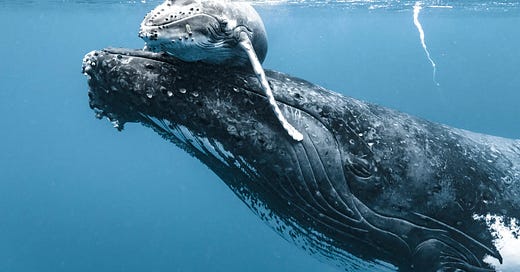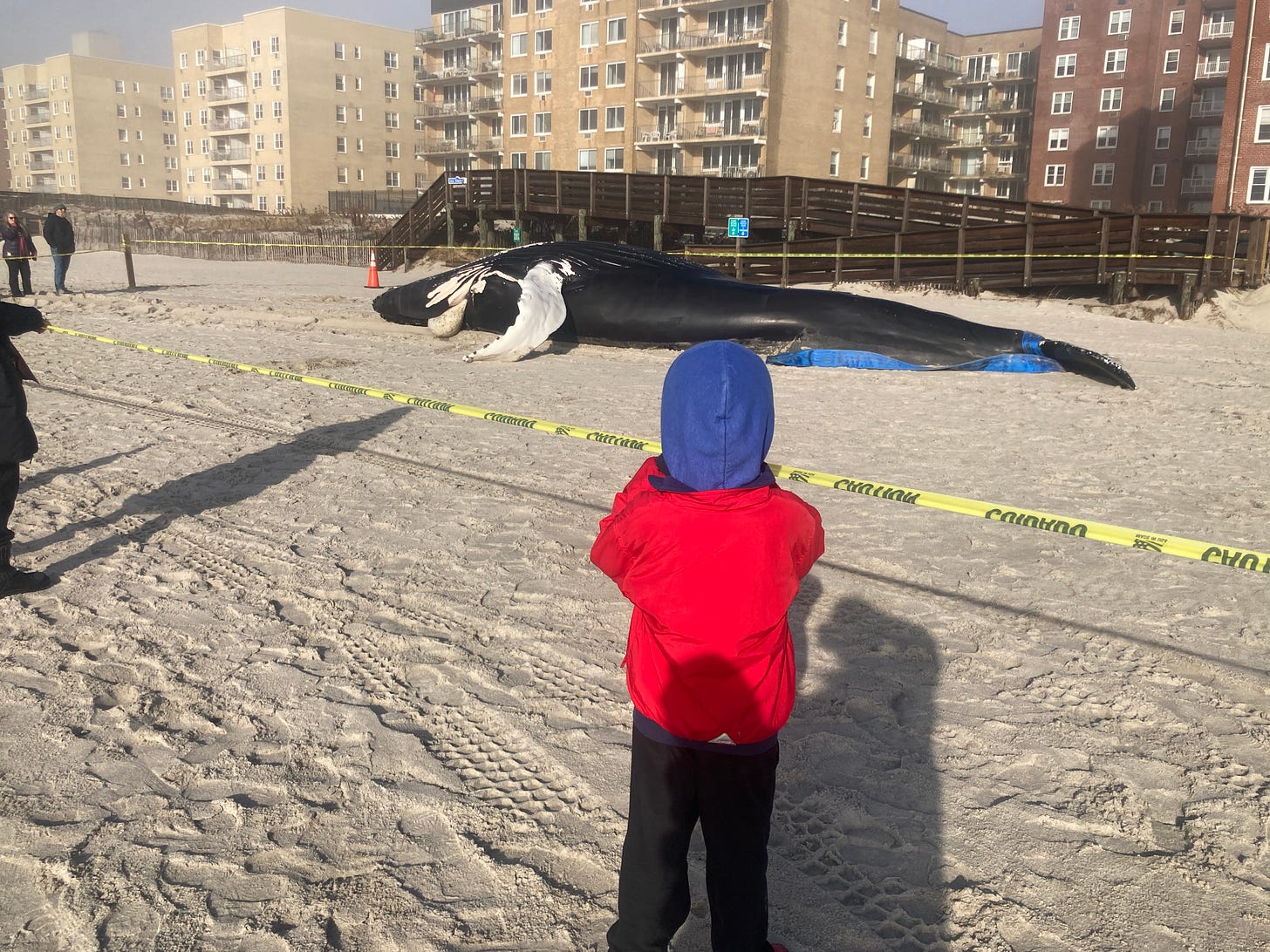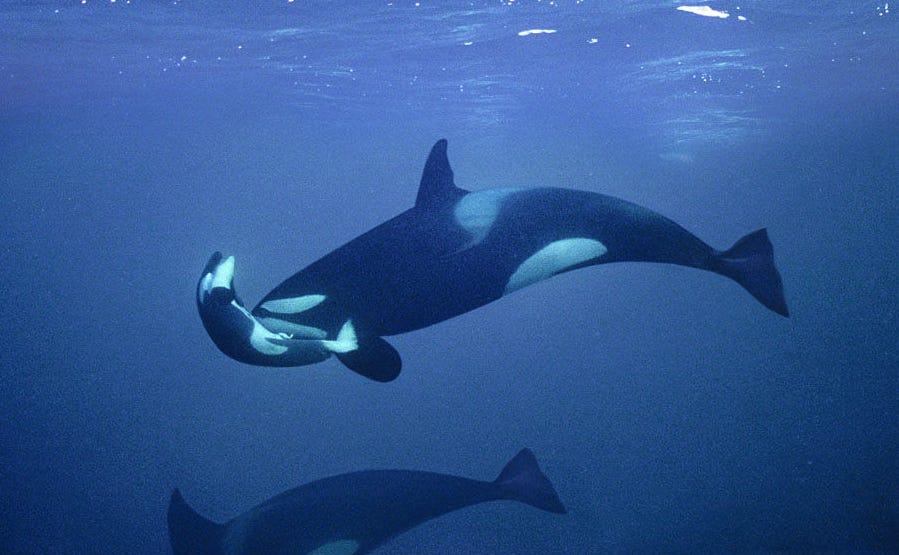On our very first weekend in Long Beach, a young humpback whale washed ashore, just a short walk from our new home.
It was a cold, sunny, late December morning, during that time-bending, off-kilter week between Christmas and New Year’s. We had moved in just two days before, our new home still cluttered with half-opened boxes, the rhythms of life already on some sort of surreal hold.
We had been spending the morning outside, exploring the new-to-us sand-bottomed playground, when we heard the news about the whale. My sons and I rushed over, and by the time we arrived, the police had pulled its enormous body onto the sand, and a small crowd of our new neighbors had gathered around it.
Its black-and-white streaked skin was marked with scratches and coated in sand. At first, it was hard to make sense of what we were seeing—the sheer size and displacement of the creature were overwhelming, otherworldly, almost impossible to comprehend.
At some point, an older officer leaned toward me and said, “He’s upside down, belly up. That’s why he looks like that.” I nodded, still struggling to fully process the sight in front of me.
And then, after a few more seconds, it all clicked into place.
Oh, hi, poor sweet whale. I see you now.
We were quickly swept up in the murmurs of our new neighbors, everyone huddled together, speaking in hushed, heartbroken tones. People wondered aloud what might happen next.
A chatty woman, the kind who seemed to thrive on sharing tidbits of insider information, leaned toward me and whispered conspiratorially, “They should call the Riverside Foundation!”—like I had any idea what she was talking about.
“Oh, yes, for sure,” I replied, as if I totally did.
As it turns out, what happened next would be as gruesome as it was fascinating. The Atlantic Marine Conservation Society was on their way to cut the whale open, right there on the beach. They needed to take samples and determine its cause of death.
The same officer glanced at his watch and addressed the crowd. “They’ll be here in a few hours if you want to come back to watch.”
“WATCH THEM CUT HIM OPEN?!” my 7-year-old shrieked, his voice gobsmacked with comical disbelief. “NO, THANKS!”
We walked away in awe, me immediately rearranging our afternoon plans to make sure we’d be back.
The rest of the day, the kids and I drifted through the motions of life at home—unpacking boxes, playing games, naps, lunch—but the memory of the whale kept breaking through.
Unpacking—“Omg, remember the whale?”
Playing cards—“I wonder what’s happening with the whale.”
Over lunch—“Should we go back to check on the whale?”
My thoughts kept traveling even further, though, to another whale who has stayed with me for years.
Maybe you remember her, too.
Her name is Tahlequah, and in July 2018, she became famous for carrying her dead newborn calf on her nose for seventeen days and over 1,000 miles through the Pacific Ocean. It was a physical act of mourning so visceral and raw, it took the world by storm.
Back then, when Tahlequah’s story broke, my oldest was just five months old. I became completely obsessed, following the updates daily.
I would read about her while holding and nursing my baby, his breath soft and rhythmic against my chest, his tiny body melting into mine—the sweetest, most delicious weight I had ever known.
As I read about her, I felt the most profound, desperate, all-consuming love of my life. It was a love that shook me to my core, connecting me to Tahlequah in a primal way deeper than I ever thought possible. I felt tied to her, to all mothers across all species—a universal thread of fierce, world-shattering love that connects those who carry life, and, by its very nature, loss, too. For when we bring life into the world, we also confront its utter fragility.
Tahlequah’s grief became my grief. Her desperate love was mine, too.
I thought of her, navigating endless miles of ocean, refusing to let her baby go. The weight of her grief—both literal and figurative—was more than I could comprehend without bursting into tears. She was carrying the calf not because she thought she could save it, but because she couldn’t yet let it go.
I’d look at my baby’s tiny hands, his soft, round cheeks, and think: I would carry you forever, too. Your weight would never break me.
I think of everything mothers carry—physical, emotional, mental, spiritual. We carry it all, long after our babies no longer sleep in our arms.
Later that afternoon, we returned to the beach to watch the scientists at work. The scene had changed—the crowd was bigger now, voices louder, a buzz of wild curiosity floating through the air.
“But why do they have to cut it open?” my son asked again, his voice small, his eyes squinting with worry. It wasn’t the first time he’d asked that day, and I gave him the same answer as before: “So they can learn what happened to it.” Then I softened, leaning into my mom-slash-preschool-teacher voice: “And to help it rest.”
We stayed—watching, chattering—until the crane began to move the whale’s massive body. The rancid, briny stench of decay hit the crowd like a tsunami wave, sudden and overwhelming.
My son and I squealed as we ran away, back down the wooden ramp, clutching each other, breathless and wide-eyed. “Oh my god, that was crazy!” we laugh-shouted, the words tumbling out in wild awe, my son’s amazement mirroring my own.
We later learned the whale was buried right beneath our beach. Its immense weight now rests under the very sand where my family and I will walk for years to come. The whale is now inextricably linked to our home, to the landscape, to our life here.
I wonder if I’ll ever be able to step on the beach without thinking of him.
Since this happened, I’ve resisted the urge to linger on dark symbolism—the ominous meanings someone might attach to such an event. While it was heavy, strange, and undeniably sad that this happened during our first weekend here, I’ve come to see it more like an invitation—a call to reflect on what it means to live here, to raise my boys here. Not just to settle into a new house, meet new neighbors, and establish new routines, but to root ourselves in something deeper: a life entwined with the wild, ancient ebb and flow of the ocean and its creatures.
To live with nature. To live with life. And to, inevitably, live with death.
Now, when I visit the beach, I offer the young humpback a quiet hello: I’m sorry you had to go, but thank you for reminding me of the power of this place.
I feel the weight of the whale beneath the sand. It pulls me back to Tahlequah and the weight she carried—to the weight all mothers carry. The weight of our children in our arms, pressed against our chests. The weight of worry, of responsibility, of a love so immense it reshapes us.
We carry it all—sometimes for miles, sometimes for years, sometimes on our noses for seventeen days.
While writing this story, I looked up Tahlequah again. On New Year’s Day of this year, 2025, she lost yet another calf. Once more, she is performing her extraordinary labor of grief, carrying the weight of her baby on her nose through miles of open sea.
I carry the weight of my now one-year-old in my arms and feel that wild, overwhelming, desperate love once again. I also think of my second pregnancy, the one in between my two boys, the one that was not viable. The life that grew within me but never made it out. How life and death are forever intertwined, two sides of the same coin, bound forever by the profound mysteries of existence.
And maybe that’s the ultimate gift the whales give me: a reminder to pause, to pay attention, to hold close the fleeting, luminous nature of life. To always remember how lucky we are, every single day, to wake up, to breathe, to feel the spark of life still burning. To see that light glowing in our children. To not know all the answers, but to stand grateful in the mystery.
To know we can carry what we need to carry.
That we can let go when we need to let go.
That we can hold space for the weight of it all.













Beautiful. The things, loved ones, grief, ritual, ancestry that mothers carry. Indeed.
Reading this made me tear up. Whales are such gorgeous creatures. Mothers are, too. Thank you for sharing such a beautiful essay with us.